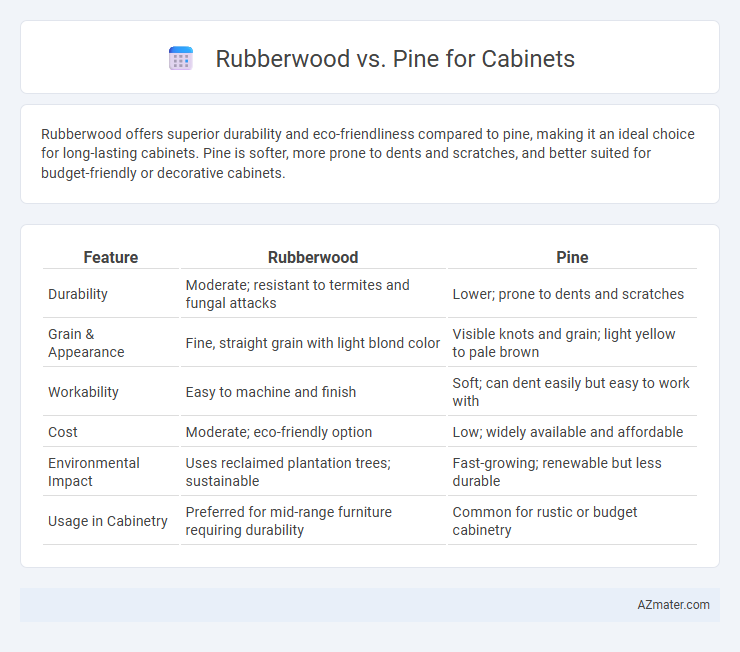Rubberwood offers superior durability and eco-friendliness compared to pine, making it an ideal choice for long-lasting cabinets. Pine is softer, more prone to dents and scratches, and better suited for budget-friendly or decorative cabinets.
Table of Comparison
| Feature | Rubberwood | Pine |
|---|---|---|
| Durability | Moderate; resistant to termites and fungal attacks | Lower; prone to dents and scratches |
| Grain & Appearance | Fine, straight grain with light blond color | Visible knots and grain; light yellow to pale brown |
| Workability | Easy to machine and finish | Soft; can dent easily but easy to work with |
| Cost | Moderate; eco-friendly option | Low; widely available and affordable |
| Environmental Impact | Uses reclaimed plantation trees; sustainable | Fast-growing; renewable but less durable |
| Usage in Cabinetry | Preferred for mid-range furniture requiring durability | Common for rustic or budget cabinetry |
Overview: Rubberwood and Pine for Cabinets
Rubberwood and pine are popular choices for cabinets due to their unique properties and cost-effectiveness. Rubberwood, derived from the parawood tree, offers high durability, resistance to warping, and an eco-friendly aspect as it is harvested from plantation trees after latex extraction. Pine, a softwood, is lightweight and easy to work with but may be more prone to dents and scratches, making it suitable for rustic or vintage-style cabinetry.
Key Differences Between Rubberwood and Pine
Rubberwood offers greater durability and resistance to warping compared to pine, making it ideal for long-lasting cabinets. Pine is a softer wood with a more pronounced grain pattern, providing a rustic and natural aesthetic but is more prone to dents and scratches. Both woods differ in weight and cost, with rubberwood being heavier and generally more expensive due to its sustainability and eco-friendly harvesting from rubber trees.
Durability and Strength Comparison
Rubberwood offers superior durability and strength compared to pine, making it an ideal choice for cabinets that require long-lasting performance. Its dense grain structure resists dents and scratches better than pine, which is softer and more prone to damage. Rubberwood's resistance to warping and cracking under moisture conditions enhances cabinet longevity, whereas pine may require more maintenance in humid environments.
Appearance and Grain Patterns
Rubberwood cabinets feature a light, creamy color with subtle, straight grain patterns that create a smooth, uniform appearance ideal for modern and minimalist designs. Pine offers a warm, honey-toned hue with distinctive knots and swirling grain, giving cabinets a rustic, natural charm perfect for cottage or farmhouse styles. The choice between rubberwood and pine hinges on the desired visual texture; rubberwood provides a clean, consistent look while pine introduces character through its knots and varied grain patterns.
Cost and Affordability Analysis
Rubberwood cabinets generally offer a more cost-effective option compared to pine due to the efficient use of harvested rubber trees after latex production. Pine tends to be pricier because of its durability and aesthetic appeal, but softer pine can be less expensive and more prone to dents and scratches. For budget-conscious projects, rubberwood provides affordability without sacrificing strength, making it a favorable choice for cabinets.
Workability and Ease of Use
Rubberwood offers superior workability due to its consistent grain pattern and medium hardness, making it easy to cut, sand, and shape for cabinet construction. Pine is softer and more prone to dents and scratches, but its lightweight nature simplifies handling and assembly. Both woods accept finishes well, but rubberwood's stability reduces the risk of warping, enhancing its ease of use in cabinetry projects.
Environmental Impact and Sustainability
Rubberwood is considered more environmentally sustainable than pine due to its use of plantation-grown rubber trees that are harvested after latex production ends, reducing deforestation and waste. Pine, typically sourced from faster-growing softwood forests, can contribute to deforestation if not managed sustainably but often grows in managed plantations with shorter rotation cycles. Rubberwood's certification through FSC and its biodegradability further enhance its eco-friendly profile compared to conventional pine cabinetry options.
Maintenance and Longevity
Rubberwood cabinets offer superior durability and resistance to warping compared to pine, requiring minimal maintenance with occasional polishing to preserve their natural finish. Pine cabinets, while more susceptible to dents and scratches, benefit from easier repairs and refinishing but need regular sealing to prevent moisture damage. Choosing rubberwood ensures longer lasting cabinetry with less upkeep, while pine offers a softer aesthetic that demands consistent care for longevity.
Best Applications in Cabinetry
Rubberwood excels in cabinetry for its durability and resistance to warping, making it ideal for kitchen cabinets and bathroom vanities exposed to humidity. Pine offers a lightweight and cost-effective option, best suited for decorative cabinets, shelves, and furniture requiring a rustic or country style. Choosing Rubberwood is optimal for long-lasting, moisture-prone environments, while Pine fits well in budget-friendly, low-moisture interior cabinetry.
Pros and Cons: Rubberwood vs Pine Cabinets
Rubberwood cabinets offer durability and resistance to warping, making them ideal for humid environments, while their eco-friendly nature supports sustainable forestry practices. Pine cabinets are lightweight, easy to work with, and provide a rustic aesthetic, but they are softer and more prone to dents and scratches compared to hardwood options. Choosing between rubberwood and pine depends on prioritizing durability and environmental benefits versus cost-effectiveness and ease of customization.

Infographic: Rubberwood vs Pine for Cabinet
 azmater.com
azmater.com